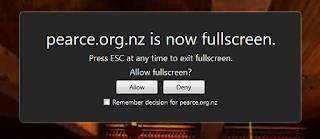The HTML fullscreen API is a little different from other JS APIs that require permission, in that it doesn't ask permission before entering fullscreen, it asks forgiveness *after* entering fullscreen.
The rationale for having our fullscreen API implementation ask forgiveness rather than request permission is to make it easier on script authors.
When the original API was designed, we had a number of HTML/JS APIs like the geolocation API that would ask permission. The user was prompted to approve, deny, or ignore the request, though they could re-retrieve the request later from an icon in the URL bar to approve the request at a later time.
The problem with this design for script authors is that they can't tell if the user has ignored the approval request, or is just about to go back and approve it by bringing up the geolocation door-hanger again.
This model of requesting permission has been seen to cause problems for web apps in the wild using the geolocation API. Often if a user ignores the geolocation permission request, the web app doesn't work right, and if you approve the request some time later, the site often doesn't start working correctly. The app just doesn't know if it should throw up a warning, or if it's about to be granted permission.
So the original developers of the fullscreen spec (Robert O'Callahan, and later I and others were involved), opted to solve this problem by having our implementation ask forgiveness. Once you've entered fullscreen, the user is asked to confirm the action.
This forces the user to approve or deny the request immediately, and this means that script will immediately know whether fullscreen was engaged, so script will know whether it needs to take its fallback path or not.
Note that the specification for requestFullscreen() defines that most of the requestFullscreen() algorithm should run asynchronously, so there is scope to change the fullscreen approval dialog to being a permission request before entering fullscreen instead if future maintainers, or other implementors/browser, wish to do so.
 |
| Firefox's fullscreen approval dialog, which asks "forgiveness" rather than permission. |
When the original API was designed, we had a number of HTML/JS APIs like the geolocation API that would ask permission. The user was prompted to approve, deny, or ignore the request, though they could re-retrieve the request later from an icon in the URL bar to approve the request at a later time.
 |
| Geolocation approval dialog, from Dive Into HTML's geolocation example. |
This model of requesting permission has been seen to cause problems for web apps in the wild using the geolocation API. Often if a user ignores the geolocation permission request, the web app doesn't work right, and if you approve the request some time later, the site often doesn't start working correctly. The app just doesn't know if it should throw up a warning, or if it's about to be granted permission.
So the original developers of the fullscreen spec (Robert O'Callahan, and later I and others were involved), opted to solve this problem by having our implementation ask forgiveness. Once you've entered fullscreen, the user is asked to confirm the action.
This forces the user to approve or deny the request immediately, and this means that script will immediately know whether fullscreen was engaged, so script will know whether it needs to take its fallback path or not.
Note that the specification for requestFullscreen() defines that most of the requestFullscreen() algorithm should run asynchronously, so there is scope to change the fullscreen approval dialog to being a permission request before entering fullscreen instead if future maintainers, or other implementors/browser, wish to do so.






